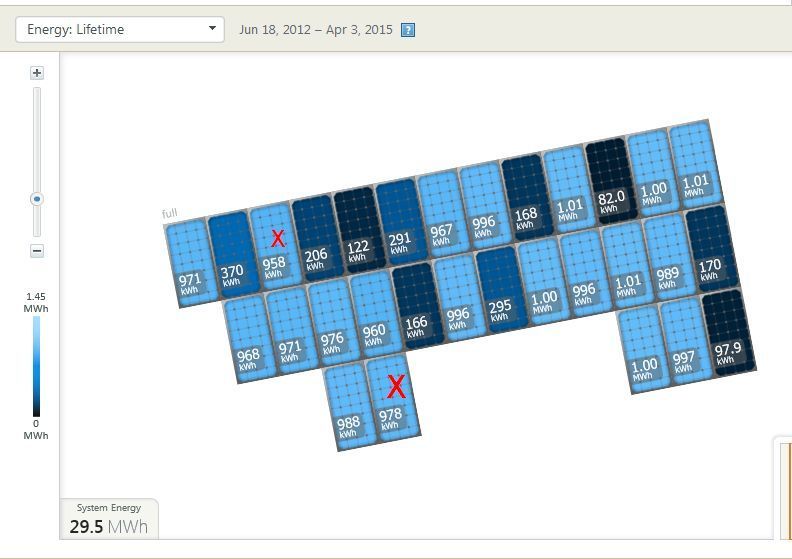RegGuheert
Well-known member
Thanks for the picture! Very cool! That does look like an M215 footprint to me and those are, in fact, Nichicon PW-style aluminum electrolytic capacitors. It is also clear that this unit was assembled in 2010 or later, since many of the components have late-2009 and early 2010 date codes on them.dsinned said:This photo was posted some time ago by one of the HW Engineers that works at Enphase. It is a photo of an Enphase Microinverter model M215, serial no. 1, so I believe it is a prototype design. Four very large (Nichicon?) electrolytic capacitors are quite evident.
Unfortunately, since we cannot see the capacitance or voltage rating for the electrolytic capacitors shown, we cannot make a direct judgement whether they are low-voltage capacitors that would be used at the input to the inverter or if they are high-voltage capacitors that would be used in between a boost converter and a buck converter. I suspect these capacitors in that picture are, in fact, at the input to the inverter, just like they were in the M190 architecture. Here is what Enphase said in their brief on capacitor life in 2008 prior to the release of the M190:
But I still wonder if Enphase shipped M215s to customers containing aluminum electrolytic capacitors. As mentioned, it was rumored that they developed a new two-stage inverter architecture which eliminated the need for electrolytic capacitors. In fact, Enphase provides a link to US Patent 8,659,922, Photovoltaic module-mounted AC inverter, which details such an inverter. This patent application is very clear that part of the intent of the claimed architecture was to eliminate electrolytic capacitors and use only solid-dielectric capacitors:Enphase Energy - Reliability Study of Electrolytic Capacitors in a Micro-Inverter said:A capacitor is commonly used to store the energy that must be stored and retrieved by the inverter. This capacitor is usually located on the PV bus, and has to be large enough to control the voltage ripple across the bus. This ripple would be detrimental to MPPT accuracy otherwise.
Electrolytic capacitors are very well suited to control the ripple because of their low Equivalent Series Resistance (ESR) and high capacitance per volume.
US Patent No. 8 said:A photovoltaic module-mounted AC inverter circuit uses one or more integrated circuits, several switches, solid dielectric capacitors for filtering and energy storage, inductors for power conversion and ancillary components to support the above elements in operation.
Note how different the above verbiage is regarding electrolytic capacitors when compared with what was written in 2008.US Patent No. 8 said:Previous attempts at development and marketing of AC modules have met with little or no success. The primary reason has been that the sales volume was too low to achieve any kind of economy of scale. The components used in the associated inverters were off-the-shelf, and in many cases were not optimum for the application. The inverter lifetime was limited by many of these components, especially the electrolytic capacitors. The reliability levels of existing off-the-shelf components used in the inverters has limited their lifetime to between five and ten years.
What is desired, therefore, is a circuit that uses a minimum number of components, uses no limited reliability components and has been optimized for large-scale manufacturing.
US Patent No. 8 said:According to the present invention, a PV module-mounted AC inverter circuit uses one or more integrated circuits, several power transistors configured as switches, several solid-dielectric capacitors for filtering and energy storage, several inductors for power conversion and ancillary components to support the above elements in operation.
US Patent No. 8 said:6. The apparatus of claim 1 wherein the power conversion module is a buck converter, and wherein the inverter further comprises a boost converter and a charge storage.
This patent even proposes the possibility of implementing the energy storage element as an inductor rather than a capacitor:US Patent No. 8 said:13. The apparatus of claim 6, wherein the boost converter further comprises two parallel connected inductors operating in quadrature phase so that neither inductor is simultaneously discharged.
This patent also focuses on the reduction of the number of components in the inverter:US Patent No. 8 said:Charge storage 204 is normally implemented as a capacitor, but may also be implemented as flux storage by utilizing an inductor and changing DC bus 205 to a current mode of operation.
US Patent No. 8 said:The prior art PV module-mounted inverter 101 utilizes between 200 and 1000 standard components to perform its functions. The large number of components requires a large dimension for the enclosure of the inverter and significantly reduces the reliability and maximum lifetime of the device.
Finally, the following introduction video for the M215 microinverter talks about the architecture of the new generation:US Patent No. 8 said:The assembly of the monitoring system 211, communications system 212 and control system 213 into integrated circuit 210 results in a total component count for the present invention PV module-mounted inverter 201 of between 20 and 80 components. This is significantly less than that for the prior art PV module-mounted inverter 101 and leads to a significant reduction of present invention PV module-mounted inverter 201 cost and a tremendous improvement in reliability. Reliability is further enhanced since a custom integrated circuit 210 can be designed to achieve a lifetime of 25 years that well exceeds the lifetime of 10 years for typical off-the-shelf commercial integrated circuits. The integrated circuit 210 may also include active and passive components of boost converter 203 and buck converter 206.
[youtube]http://www.youtube.com/watch?v=P8Q9YE6XdYk[/youtube]Enphase Energy at 1:14 in the M215 Introduction video said:Enphase was able to achieve the higher-power output through a completely new inverter architecture which uses a variety of custom-developed components with an ultra-low profile.







